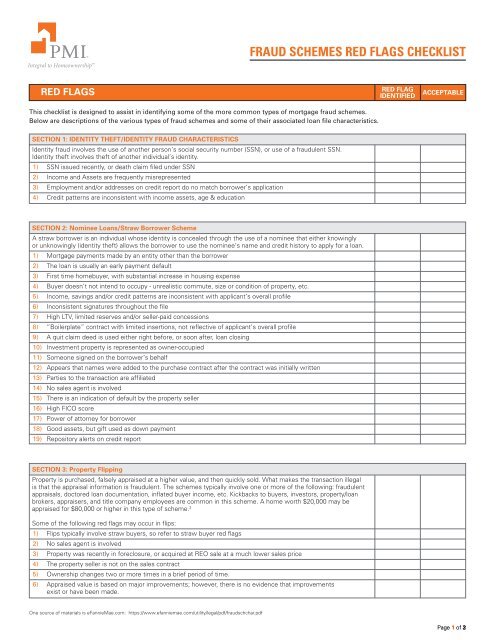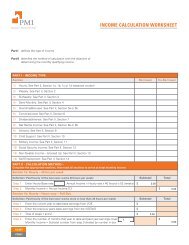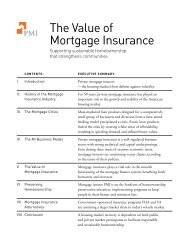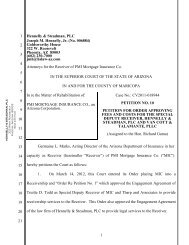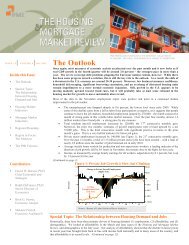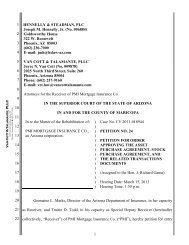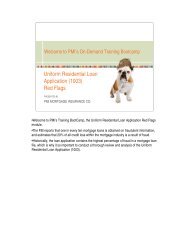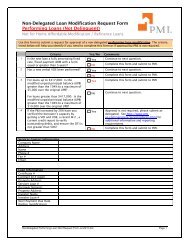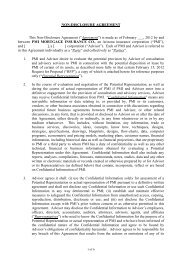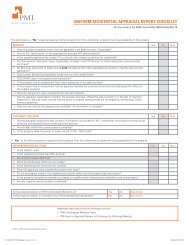Create successful ePaper yourself
Turn your PDF publications into a flip-book with our unique Google optimized e-Paper software.
<strong>FRAUD</strong> <strong>SCHEMES</strong> <strong>RED</strong> <strong>FLAGS</strong> <strong>CHECKLIST</strong><strong>RED</strong> <strong>FLAGS</strong><strong>RED</strong> FLAGIDENTIFIEDACCEPTABLEThis checklist is designed to assist in identifying some of the more common types of mortgage fraud schemes.Below are descriptions of the various types of fraud schemes and some of their associated loan file characteristics.SECTION 1: IDENTITY THEFT/IDENTITY <strong>FRAUD</strong> CHARACTERISTICSIdentity fraud involves the use of another person’s social security number (SSN), or use of a fraudulent SSN.Identity theft involves theft of another individual’s identity.1) SSN issued recently, or death claim filed under SSN2) Income and Assets are frequently misrepresented3) Employment and/or addresses on credit report do no match borrower’s application4) Credit patterns are inconsistent with income assets, age & educationSECTION 2: Nominee Loans/Straw Borrower SchemeA straw borrower is an individual whose identity is concealed through the use of a nominee that either knowinglyor unknowingly (identity theft) allows the borrower to use the nominee’s name and credit history to apply for a loan.1) Mortgage payments made by an entity other than the borrower2) The loan is usually an early payment default3) First time homebuyer, with substantial increase in housing expense4) Buyer doesn’t not intend to occupy - unrealistic commute, size or condition of property, etc.5) Income, savings and/or credit patterns are inconsistent with applicant’s overall profile6) Inconsistent signatures throughout the file7) High LTV, limited reserves and/or seller-paid concessions8) “Boilerplate” contract with limited insertions, not reflective of applicant’s overall profile9) A quit claim deed is used either right before, or soon after, loan closing10) Investment property is represented as owner-occupied11) Someone signed on the borrower’s behalf12) Appears that names were added to the purchase contract after the contract was initially written13) Parties to the transaction are affiliated14) No sales agent is involved15) There is an indication of default by the property seller16) High FICO score17) Power of attorney for borrower18) Good assets, but gift used as down payment19) Repository alerts on credit reportSECTION 3: Property FlippingProperty is purchased, falsely appraised at a higher value, and then quickly sold. What makes the transaction illegalis that the appraisal information is fraudulent. The schemes typically involve one or more of the following: fraudulentappraisals, doctored loan documentation, inflated buyer income, etc. Kickbacks to buyers, investors, property/loanbrokers, appraisers, and title company employees are common in this scheme. A home worth $20,000 may beappraised for $80,000 or higher in this type of scheme. 2Some of the following red flags may occur in flips:1) Flips typically involve straw buyers, so refer to straw buyer red flags2) No sales agent is involved3) Property was recently in foreclosure, or acquired at REO sale at a much lower sales price4) The property seller is not on the sales contract5) Ownership changes two or more times in a brief period of time.6) Appraised value is based on major improvements; however, there is no evidence that improvementsexist or have been made.One source of materials is eFannieMae.com: https://www.efanniemae.com/utility/legal/pdf/fraudschchar.pdfPage 1 of 32
<strong>FRAUD</strong> <strong>SCHEMES</strong> <strong>RED</strong> <strong>FLAGS</strong> <strong>CHECKLIST</strong><strong>RED</strong> <strong>FLAGS</strong><strong>RED</strong> FLAGIDENTIFIEDACCEPTABLESECTION 3: Property Flipping (continued)7) Two or more closings occur almost simultaneously8) The property has been owned for a short time by the seller9) The property seller is not on title10) There is a reference to double escrow or other HUD-1 form11) Parties to the transaction are affiliated12) Up and down fluctuation of sales price over short period of time13) Multiple investment properties obtained by same buyer within short timeframe14) “Purchases” disguised as “refinances” to circumvent a down payment15) Property seller is an entity/corporation16) Unusual cash payouts at closing on HUD-I17) Comparable sales on appraisal are previously flipped propertiesSECTION 4: Builder Bailout SchemeWhen the market slows and sales begin to lag, the builder and other industry professionals may engage inquestionable practices in order to move the remaining inventory of properties. The builder will typically offer secret/hidden incentives that may be fraudulent in order to sell the property quickly. Bail-outs typically involve: newconstruction; properties in resort-like upscale communities; straw borrowers often recruited from out of state. 11) Builder's marketing material advertises rent credit to investors, and/or payment credit2) HUD-1 reflects unexplained pay-outs or inflated commissions (paid outside closing to buyer)3) Builder has provided incentives and/or sales concessions possibly not shown on the contract but stated inthe MLS listing (if any) or ads4) The borrower is barely qualified or unqualified5) The sales price and appraisal are inflated6) No-money-down sales are included7) “Silent” second mortgages are involved; may appear as a credit inquiry on the credit report or on theHUD-1 after the close of escrow8) The sales price is adjusted upwards9) The source of funds is questionable, such as borrowed funds or funds from an unverifiable source10) There is a reference to secondary financing on HUD-1 or purchase contract11) Parties to the transaction are affiliated12) Multiple sales to same personSECTION 5: AIR LOAN CHARACTERISTICSAn air loan is a loan to a straw or non-existent buyer, on a non-existent property.1) Typically involves straw or non-existent buyer, on a non-existent property.2) No real estate agent is employed (fictitious transaction)3) Mortgage payments are made by an entity other than the borrower4) Common payer among loans in scheme5) Common mailing address among loans in scheme6) Unable to independently validate chain of title7) The lender is experiencing financial distressOne source of materials is eFannieMae.com: https://www.efanniemae.com/utility/legal/pdf/fraudschchar.pdfPage 12 of 3
<strong>FRAUD</strong> <strong>SCHEMES</strong> <strong>RED</strong> <strong>FLAGS</strong> <strong>CHECKLIST</strong><strong>RED</strong> <strong>FLAGS</strong>SECTION 6: DOUBLE SALE CHARACTERISTICSA double sale is the sale of one mortgage note to more than one investor.1) Mortgage payments are made by an entity other than the borrower2) Mailing address is not the borrower’s address3) Two mortgages recorded on the same property4) Mortgage is not recorded in first-lien position5) The lender is experiencing financial distress6) Two notes may be identical except for signatures (or one may be a color copy)<strong>RED</strong> FLAGIDENTIFIEDACCEPTABLESECTION 7: PONZI/INVESTMENT CLUB/CHUNKING CHARACTERISTICSThe sale of properties at artificially inflated prices, pitched as investment opportunities to naive real estateinvestors who are promised improbably high returns and low risks.1) No sales agent is involved2) Property was recently in foreclosure, or acquired at REO sale at a much lower sale price3) Borrower may have paid a membership fee to participate in the “club”4) First-time landlord, non-savvy investors5) Seller offers to manage these rental properties6) Borrower may have been told that the seller or the “club” would make mortgage payments7) Borrower purchased multiple properties simultaneously, but did not disclose other loans in process to theirlender (“shot-gunning”); watch for credit inquiries8) The appraised value is fraudulently inflated1. The information at these sites is subject to change, and PMI does not represent that the content of these sites is either correct or current.2. These resources are a source of information, but do not substitute for1Recognizing Mortgage Fraud, http://www.michbar.org/realpreoprty/pdfs/lax.pdf2The FBI 2006 Financial Crime reportOne source of materials is eFannieMae.com: https://www.efanniemae.com/utility/legal/pdf/fraudschchar.pdf© 2009 PMI Mortgage Insurance Co. 09-0318 (11.09) Page 13 of 3


